The FIFA World Cup, the largest sporting event in the world, is returning this November. Four and a half years since the last tournament in Russia, the much anticipated event is set to take place in Qatar. Qatar won the bid to host the World Cup back in 2010 amid strong competition from the US and Australia, becoming the first country in the Middle East to host the event. The tournament is set to bring billions of viewers and hundreds of thousands of tourists into the nation. In preparation for the event, Qatar has built stadiums, highway lines, a metro system, and even a new airport, spending a staggering 220 billion USD in the process — 16 times more than what Russia spent on the last World Cup. The World Cup was, in part, an attempt by Qatar to establish a more global image. However, the competition has brought more controversy than anticipated. Behind all the hype and excitement, Qatar has been criticized for a number of reasons, most of which revolve around the treatment of migrant workers. The controversy surrounding these issues has somehow overshadowed the beautiful game.
Migrant workers account for the majority of the personnel constructing World Cup sites. The working and living conditions of these migrant workers has consistently been questioned by bodies such as the International Labor Organization (ILO). In February last year, The Guardian reported that in the 10 years since Qatar won the bid to host the competition, more than 6,000 workers have died for various reasons related to the World Cup — 12 workers every week for 10 years straight. According to the report, this figure only includes workers coming from five countries in South Asia and based on estimates, the actual death count is even higher. The Qatar government has refuted the claims and said the report was completely misleading, maintaining that not all workers were working on the sites and that almost all reported deaths were not related to the World Cup at all. According to government records between 2014 and 2020, there were 37 deaths in World Cup related sites, of which 34 were not work-related. However, FairSquare, a workers’ rights advocacy group, reported that a vast majority of the workers whose deaths were reported in The Guardian were only in Qatar because of the World Cup. In addition, they noted that workers who died from working under extreme heat and lack of adequate healthcare were not considered in the government’s report.

The figures proposed by The Guardian and those proposed by the Qatar government have a stark difference and there is still no consensus on the “human cost” of hosting the tournament. And whether or not Qatar underreported the number of casualties, the World Cup has shed light on the terrible working conditions of migrant workers in the country. Official figures from the Qatar government indicate that thousands of migrant workers have died since 2010. What is not clear, however, are the details of these deaths, as most were either not investigated and certified, or explained with vague terms such as “natural causes” or “unknown causes”. The government’s inability to provide a proper explanation only serves to show the disregard towards the migrant population, who contributed significantly to making Qatar what it is today.
Up until 2019, migrant workers in Qatar were monitored under the Kafala system, a system which tied a worker’s visa status to their company. This meant that workers couldn’t easily leave abusive jobs or demand change without the willingness of their employers, which contributed to their exploitation. In 2019, Qatar abolished the Kafala system and amended the labor laws. The improvements include the establishment of labor courts and a wage protection system. They also extended the hours in which outdoor work is prohibited during the summer because of extreme heat. Nevertheless, how well the improved system is being implemented is still questionable. The World Cup has shed light on the abuse, but unless the issues are taken seriously, they are to be forgotten by December when the tournament ends.

